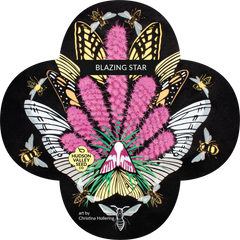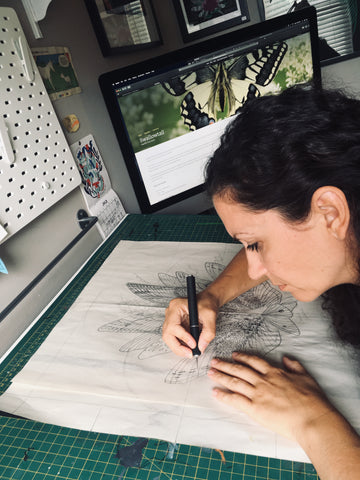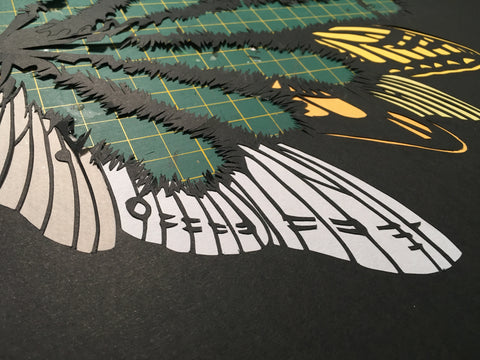 Blazing Star, a Liatris variety also known as Gayfeather, has an unusual trick: it unfurls blooms from tip to stem, like a flame descending a sparkler stick, unlike most vertically-spiking plants, which bloom from the bottom up. The spikes take on an enchanting ombre tone as they move from the bud to flower stage. No wonder it is so attractive to so many pollinators—it draws in crowds of butterflies, moths, bees, nymphs, and hummingbirds. The larvae of the spectacular Bleeding Flower Moth (or Glorious Flower Moth), depicted in the artwork, feed on the leaves of Liatris species such as this. These reasons alone would have been enough to attract us to Blazing Star just like a moth, but we also love it because it's a native flower variety. When we chose it to be part of our 2020 Art Pack Collection, we knew we needed an artist who could highlight not only the plant's beauty, but its important role as a pollinator in our communities.
Blazing Star, a Liatris variety also known as Gayfeather, has an unusual trick: it unfurls blooms from tip to stem, like a flame descending a sparkler stick, unlike most vertically-spiking plants, which bloom from the bottom up. The spikes take on an enchanting ombre tone as they move from the bud to flower stage. No wonder it is so attractive to so many pollinators—it draws in crowds of butterflies, moths, bees, nymphs, and hummingbirds. The larvae of the spectacular Bleeding Flower Moth (or Glorious Flower Moth), depicted in the artwork, feed on the leaves of Liatris species such as this. These reasons alone would have been enough to attract us to Blazing Star just like a moth, but we also love it because it's a native flower variety. When we chose it to be part of our 2020 Art Pack Collection, we knew we needed an artist who could highlight not only the plant's beauty, but its important role as a pollinator in our communities.
The artist who fluttered into the finalists' round of our Call for Art was Christina Hollering. Herself a native of Indiana, Christina's work pulls from both hard science and science fiction to bring out the magnificent in the ordinary finds from our backyards. One of her favored mediums, cut paper, shows her respect for the little details in a very real way. Using this exacting and evocative method, Christina brought a plethora of pollinators and their beloved Blazing Star to life for this new Art Pack. We had the pleasure of speaking with Christina about her work.
Tell us a bit about your artistic medium. What should people know about your process?
 I work primarily in cut paper. My work is inspired by the natural world, specifically insects and their host plants. I use my work to educate, inspire and generate a desire to protect and preserve some of the underappreciated creatures we share our planet with.
I work primarily in cut paper. My work is inspired by the natural world, specifically insects and their host plants. I use my work to educate, inspire and generate a desire to protect and preserve some of the underappreciated creatures we share our planet with.
The history of paper cutting goes back to the 4th century AD in China where it appeared shortly after paper was invented. Today it can be found in practically all cultures in a variety of forms. I personally enjoy using paper because it’s versatile, it’s a renewable resource, and it’s extremely recyclable. I like that I can use it to create small detailed pieces or large installations. Although I usually begin with a full scale drawing that is used as a template, I will work intuitively and collage other cut-out elements onto the composition as needed. I also cut, layer, and stitch Mylar, a semi transparent plastic, into my pieces. The Mylar has a translucent quality similar to insect wings and takes colored pencil wonderfully. Mylar can also be layered to add a sense of depth or to mimic the body segments of an insect.
What are your favorite elements of this artwork? Any details you want folks to notice?
 I wanted the blazing star to be the focal point and to act as a “magnet” to the various wings, moths, and bees to emphasize the wide variety of pollinators that visit Blazing Star. I’ve included wings from the Swallowtail Butterfly, the Glorious Flower Moth, the Clouded Sulfur Butterfly, and the Gray Hairstreak Butterfly. I also wanted to include the wide variety of bees that the blazing star attracts, including some of the lesser known solitary bees such as the Digger Bee and the Miner Bee. My favorite element of this artwork would have to be the five Glorious Flower Moths I added to the piece. I really wanted them to have a starring role in the piece since Blazing Star is their only host plant.
I wanted the blazing star to be the focal point and to act as a “magnet” to the various wings, moths, and bees to emphasize the wide variety of pollinators that visit Blazing Star. I’ve included wings from the Swallowtail Butterfly, the Glorious Flower Moth, the Clouded Sulfur Butterfly, and the Gray Hairstreak Butterfly. I also wanted to include the wide variety of bees that the blazing star attracts, including some of the lesser known solitary bees such as the Digger Bee and the Miner Bee. My favorite element of this artwork would have to be the five Glorious Flower Moths I added to the piece. I really wanted them to have a starring role in the piece since Blazing Star is their only host plant.
What do you hope this work of art says about you as an artist and about the variety?
 I was really blown away by the variety of pollinators Blazing Star attracts and really wanted to illustrate that by including as many as I could fit onto the image. I hope that the illustration effectively communicates that and that my passion for conservation, education and love of pollinators is expressed in this piece since Blazing Star is their only host plant. I just really love the beautiful pink and magenta wings of these moths and feel they really compliment the yellow and gray hues used in the wings behind the Blazing Star.
I was really blown away by the variety of pollinators Blazing Star attracts and really wanted to illustrate that by including as many as I could fit onto the image. I hope that the illustration effectively communicates that and that my passion for conservation, education and love of pollinators is expressed in this piece since Blazing Star is their only host plant. I just really love the beautiful pink and magenta wings of these moths and feel they really compliment the yellow and gray hues used in the wings behind the Blazing Star.
How do you see art and gardening as being connected?
I find that art and gardening are mindful activities that require planning and patience before you can reap the rewards. They are also both visual displays of your patience, knowledge and creativity that can be shared with others. Both are also susceptible to unpredictable life events such as sickness or weather that will test you but also strengthen you as a person by teaching you perseverance and patience. ■
Christina's patience, as well as her artistic vision, are clearly visible on this Art Pack, which is sure to be a best-seller. And as for perseverance: with the help of the Blazing Star seeds inside, gardeners can help some very special pollinators persevere too.
You can find more of Christina's work on her website and on Instagram @christinahollering.
How to Grow Blazing Star
For spring sowing, sow 8-10 weeks before last frost in deep seed-starting pots about ¼" deep, in rich, damp soil. Germination can be encouraged and will happen faster, if seeds are then covered and refrigerated for 3-4 weeks. Afterwards, move to a 70-degree, well-lit spot for germination, which will occur in 20-45 days. Transplant outdoors after frost in an area where plants can naturalize. Perennial—plants usually do not bloom until the second year.





